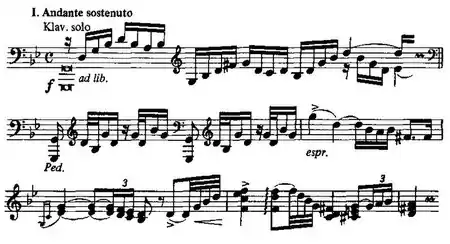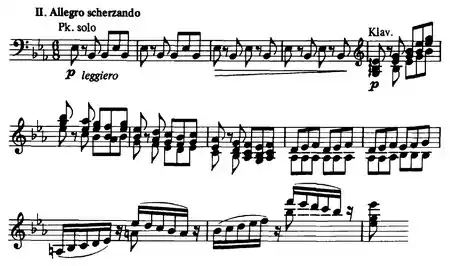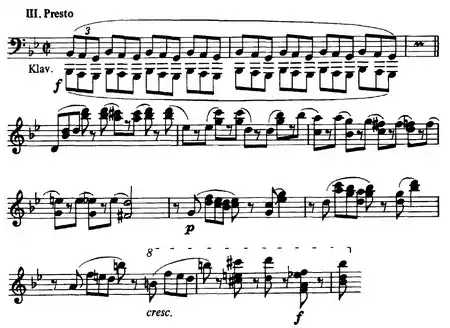Piano Concerto No. 2 (Saint-Saëns)
The Piano Concerto No. 2 in G minor, Op. 22 by Camille Saint-Saëns was composed in 1868 and is probably Saint-Saëns' most popular piano concerto. It was dedicated to Madame A. de Villers (née de Haber). At the première, the composer was the soloist and Anton Rubinstein conducted the orchestra. Saint-Saëns wrote the concerto in three weeks and had very little time to prepare for the première; consequently, the piece was not initially successful. The capricious changes in style provoked Zygmunt Stojowski to quip that it "begins with Bach and ends with Offenbach."[1]
Overview
The piece follows the traditional form of three movements but allows for more freedom in tempo markings. Normally, the first movement is fast-paced, while the second is slower, but the first movement here is slow and the second movement has a scherzo-like quality, resulting in a form resembling a typical four-movement symphony but lacking the first movement (a form also represented by Beethoven's Moonlight Sonata).
The movements in the concerto are:
- Andante sostenuto (in G minor and sonata form)
- The concerto begins with a piano solo playing a long improvisational introduction in the style of a Bach fantasia. After the orchestra enters, the restless and melancholy first theme is played, again by the piano solo. Saint-Saëns drew the theme from his student Gabriel Fauré's abandoned Tantum ergo motet. A brief second theme appears, followed by a middle section of increasing degrees of animato. The main theme is recapitulated fortissimo and the soloist is given a long ad libitum cadenza. The Bach-like opening motif returns in the coda.

- Allegro scherzando (in E-flat major and sonata form)
- The second movement is in E-flat major and, instead of being a typical adagio, resembles a scherzo. The mercurial piano part is marked leggieramente, and the two main themes are clever and light-hearted. The energetic, delicate personality of this particular movement is characteristic of Saint-Saëns' musical wit, most famously observable in Le Carnaval des Animaux.

- Presto (in G minor and sonata form)
- The concerto concludes by returning to G minor. Like the preceding movement, it moves quickly; this time the form is an extremely fast, fiery saltarella, in sonata form, featuring a strong triplet figure. At presto speed, the orchestra and soloist rush tumultuously along, gaining volume and momentum and finishing in a whirlwind of G minor arpeggios.

The concerto is scored for solo piano, 2 flutes, 2 oboes, 2 clarinets, 2 bassoons, 2 horns, 2 trumpets, timpani, crash cymbals and strings. A performance lasts around 23 minutes.
Influences
The concerto, particularly the second movement, heavily influenced fellow French composer Gabriel Pierné's Piano Concerto in C minor of 1887.[2]
Georges Bizet wrote a transcription of the concerto for solo piano.
The concerto is featured in the 2020 film, "Nocturne".
Recordings
- Benno Moiseiwitsch, London Philarmonic Orchestra, conducted by Basil Cameron. 1947, report CD Naxos 2002, and Royal Philharmonic Orchestra, conducted by Eugene Goossens. 1960, report CD Classica (Les introuvables) 2020 (3e mouvement).
- Emil Gilels, piano, Orchestre de La Société des Concerts du Conservatoire, conducted by André Cluytens. LP Columbia 1954 report CD Emi 2006.
- Arthur Rubinstein, piano, Symphony Of The Air, conductor Alfred Wallenstein LP RCA Victor 1958 report CD BMG Classics 1996.
- Grigory Sokolov, URSS Symphony Orchestra, conducted by Neimye Yarvy. LP Melodie Angel 1966.
- Arthur Rubinstein, piano, The Philadelphia Orchestra, conductor Eugene Ormandy. CD RCA Victor 1970 report CD Sony 2013.
- François-René Duchable, Orchestre Philharmonique de Strasbourg, conductor Alain Lombard. CD Erato 1982.
- Nelson Freire, piano, Symphnonie Orchester Berlin, conductor Adam Fisher.Live recording 1986. CD Audite Musikproduktion 2017.
- Stephen Hough, City of Birmingham Symphony Orchestra, conductor Sakari Oramo. 2 CD Hyperion 2000 - 2001. Gramophone Awards record of the year 2002. Diapason d'or, Choc Le Monde la Musique.
- Nicolaï Petrov, piano, (Georges Bizet's single piano transcript, 1868). CD Olympia 2002
- Howard Shelley, Orchestra of Opera North, piano and conducting, CD Chandos 2009
- Bertrand Chamayou, piano, Orchestre National de France, conductor Emmanuel Krivine. CD Erato 2019. Gramophone Awards, Choc de Classica.
- Nathanaël Gouin, piano, (Georges Bizet's 1868 transcription for solo piano). CD Mirare 2020
Notes
- Summaries of Saint-Saëns' Piano Concertos Archived 2014-05-28 at the Wayback Machine
- Larner, Gerald (2011). Pierné: Piano Concerto, Divertissements sure un Theme Pastoral, Suites from 'Ramuntcho,' Marche des petits solidest de plomb (CD). Chandos Records. p. 5-6.
External links
- Piano Concerto No. 2: Scores at the International Music Score Library Project